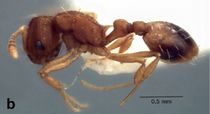Key to Wasmannia Species
The key to Wasmannia species based on workers by Longino and Fernández (2007[1]) has been modified by Cuezzo et al. (2015[2]) to include all the described species of Wasmannia (except Wasmannia villosa, which is only known from the queen).
1
- Petiolar node strongly quadrate in lateral view; petiolar peduncle about as long as node; setae on mesosomal dorsum simple and erect, color red brown to orange => Wasmannia auropunctata
- Petiolar node never quadrate, more rounded; or clypeus strongly projecting and box-like and dorsal pilosity composed of a very short stubble; petiolar peduncle longer or shorter than node; color variable => 2
2
- Petiolar peduncle longer than node in lateral view; mesosomal dorsum with long setae (length close to the length of the propodeal spine in lateral view) and gaster smooth and shiny, with abundant long (>1 mm), curved and whitish setae => Wasmannia longiseta
- Petiolar peduncle equal to node or shorter in lateral view; mesosomal dorsum with shorter setae, gaster frequently weakly punctate with fewer, scattered setae => 3
3
- Scape strongly flattened; clypeus strongly projecting and boxlike, sharply divided into equaldorsal and anterior faces that meet at a right angle; setae on mesosomal dorsum abundant, straight, filiform; very short propodeal spines, about same length as the setae on mesosomal => Wasmannia scrobifera
- Scape not strongly flattened; clypeus not strongly box-like, rounded from posterior to anterior margins; setae on mesosomal dorsum longer and/or curved, clavate; propodeal spine length variable => 4
4
- First gastral tergite lacking erect setae; petiolar peduncle longer than node; dorsal setae on mesosoma and face thin, flexuous; color yellow orange => Wasmannia iheringi
- First gastral tergite with abundant erect setae; petiolar peduncle equal to node or shorter; dorsal setae stiff to slightly clavate; color various => 5
5
- Antennal scrobe narrow, not extending to side of head, ventral margin defined by preocular carina that runs from dorsal margin of eye to margin of vertex; side of head posterior to eye rounded => 5
- Antennal scrobe broad and flat, extending to side of head, ventral margin formed by angular side of head posterior to eye => 9
6
- Face between frontal carinae with about 12 distinct longitudinal striae overlaying strong punctate sculpture; propodeal spiracle small, diameter less than width of base of propodeal spine (Argentina) => 7
- Face between frontal carinae with fewer and more irregular longitudinal rugae, overlaying opaque but not as strongly puncate sculpture; propodeal spiracle large and conspicuous, diameter about equal to width of base of propodeal spine => 8
7
- Head width less than 0.50 mm; longitudinal striae on face very regular to margin of vertex; color yellow red; posterior face of petiole rounded, anterior face slightly angulate => Wasmannia sulcaticeps
- Head width greater than 0.54 mm; striae on face somewhat less parallel, becoming irregular near margin of vertex; color uniformly dark maroon, abdomen black; anterior and posterior face of petiolar node similarly rounded => Wasmannia williamsoni
8
- Dorsal setae on mesosoma and gaster straight to weakly curved, thin, not clavate; head relatively long, CI about 0.90; propodeal spines relatively long and upturned (Fig 1); eyes relatively larger (OI 0.26) => Wasmannia sigmoidea
- Dorsal setae on mesosoma curved and clavate; head relatively short, CI 0.95-1.00; propodeal spines short and directed posteriorly; eyes shorter (OI 0.21-0.24) => Wasmannia rochai
9
- Postpetiole in dorsal view subquadrate to slightly trapezoidal, with widest portion anterior to midlength; postpetiolar dorsum strongly punctate and opaque; propodeal spines relatively long and stout, in dorsal view about as long as distance between their tips => Wasmannia lutzi
- Postpetiole in dorsal view elliptical, widest portion at or posterior to mid length; postpetiolar dorsum weakly punctate, sublucid medially; propodeal spines shorter, in dorsal view shorter than distance between tips => Wasmannia affinis
References
<references>
- ↑ Longino, J.T. & Fernández, F. 2007. Taxonomic review of the genus Wasmannia (pp. 271-289). In Snelling, R.R., Fisher, B.L. & Ward, P.S. (eds). Advances in ant systematics: homage to E.O. Wilson – 50 years of contributions. Memoirs of the American Entomological Institute 80: 690 pp.
- ↑ Cuezzo, F., Calcaterra, L.A., Chifflet, L. & Follett, P. 2015. Wasmannia Forel (Hymenoptera: Formicidae: Myrmicinae) in Argentina: Systematics and distribution. Sociobiology, 62, 246-265 (doi:10.13102/sociobiology.v62i2.246-265).



















